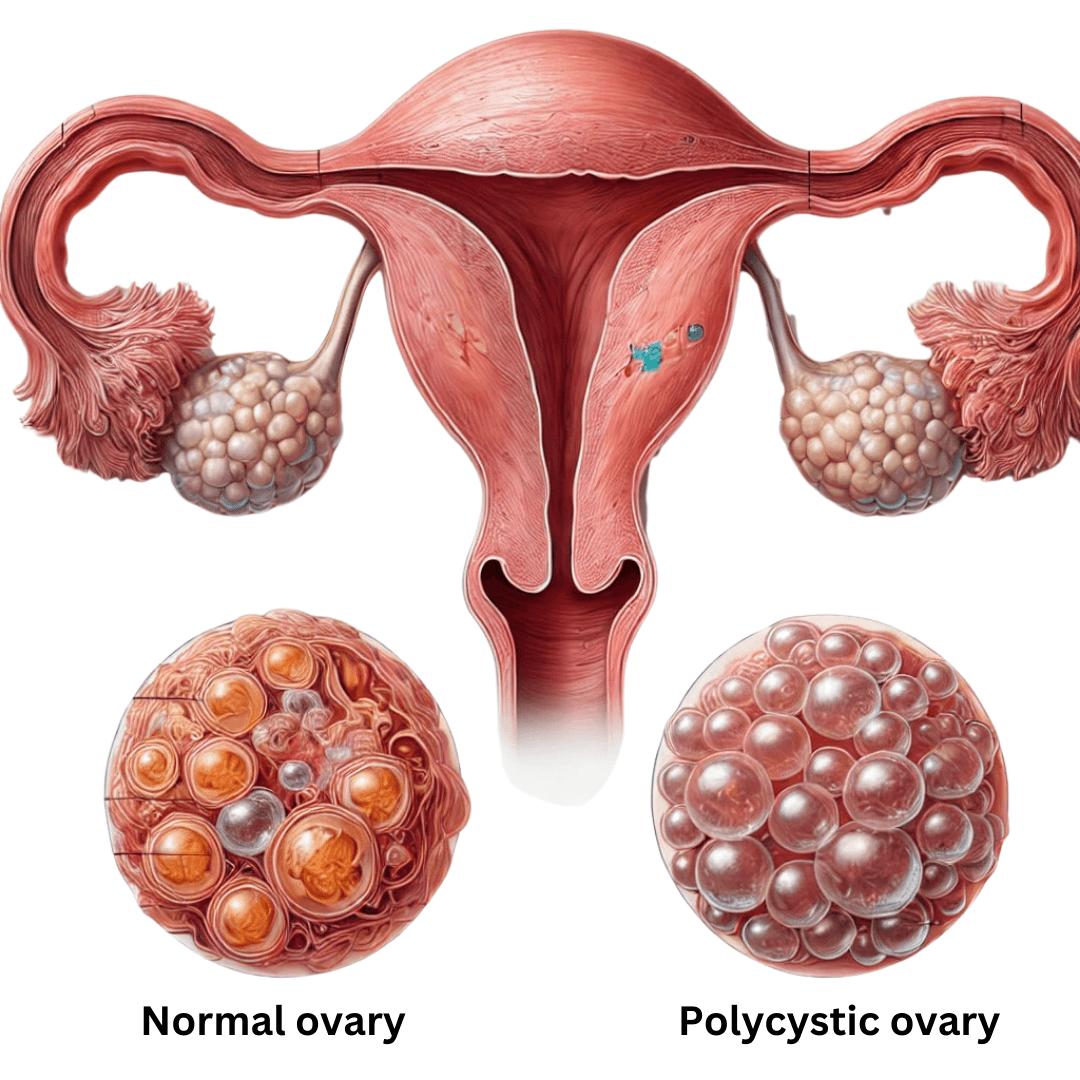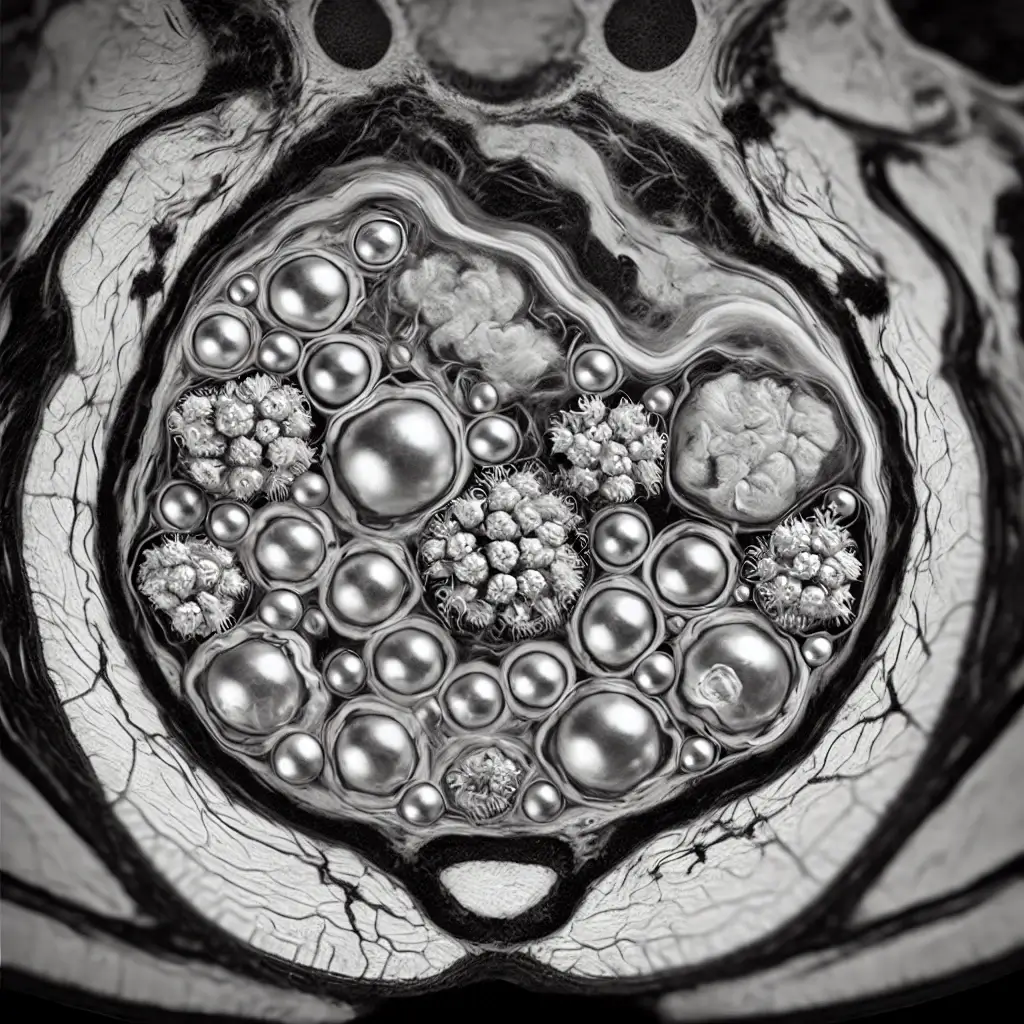Book Appointment Now
Understanding Polycystic Ovarian Syndrome

Polycystic Ovarian Syndrome Guide
Introduction
What Is Polycystic Ovarian Syndrome (PCOS)?
Polycystic ovarian syndrome (PCOS) is a common hormonal disorder that affects women of reproductive age. It is characterized by irregular menstrual cycles, elevated levels of male hormones (androgens) and the presence of multiple small cysts on the ovaries. These hormonal imbalances can lead to a range of symptoms, including weight gain, excessive facial or body hair and fertility challenges.
Why Is It Important to Learn About PCOS?
Understanding PCOS is important because:
- Common Condition: PCOS affects about 1 in 10 women of reproductive age worldwide, making it one of the most common causes of infertility.
- Health Implications: It can lead to other health issues, such as type 2 diabetes, heart disease and mental health challenges.
- Manageable Condition: With the right treatment and lifestyle changes, many symptoms of PCOS can be managed effectively, improving overall quality of life.
Recent Developments
Recent research has helped better understand the role of insulin resistance in PCOS, leading to improved treatment options, such as medications that target insulin sensitivity and personalized lifestyle interventions.
Statistical Overview
- Incidence: PCOS affects approximately 5-10% of women worldwide, making it one of the most common endocrine disorders in women.
- Age: Typically diagnosed during a woman’s reproductive years, often between the ages of 15-45.
- Long-Term Risks: Women with PCOS are at higher risk of developing other conditions, such as type 2 diabetes (affecting about 50% of women with PCOS by age 40), hypertension and cardiovascular disease.
Trends and Disparities:
- Weight Factors: PCOS is more common in women who are overweight or obese, but it can also occur in women with a healthy weight.
- Ethnic Disparities: Certain ethnic groups, such as South Asian women, have a higher prevalence of PCOS and may experience more severe symptoms.
Medical Illustrations
A detailed MRI scan image of a Polycystic Ovarian Syndrome (PCOS):

Microscopic view of ovarian tissue affected by Polycystic Ovarian Syndrome (PCOS):

Risk Factors and Prevention
a. Known Risk Factors
- Genetics: PCOS tends to run in families. If your mother or sister has PCOS, your chances of having it are higher.
- Insulin Resistance: Many women with PCOS have insulin resistance, meaning their bodies struggle to use insulin effectively, leading to higher blood sugar levels.
- Obesity: Being overweight or obese can increase the risk of developing PCOS or worsen symptoms.
b. Prevention
There is no guaranteed way to prevent PCOS, but you can reduce your risk or manage symptoms by:
- Maintaining a Healthy Weight: Regular exercise and a balanced diet can help regulate insulin levels and menstrual cycles.
- Managing Insulin Levels: A diet low in refined carbohydrates and sugars can help reduce insulin resistance, a major factor in PCOS.
- Regular Medical Check-Ups: Early diagnosis and treatment can help manage symptoms and reduce the risk of complications.
Screening
Screening Methods:
Medical History and Physical Exam: Your doctor will ask about your symptoms, menstrual cycle, and perform a physical exam.
Blood Tests: To measure hormone levels, including androgens and insulin.
Ultrasound: To check for the presence of multiple small cysts on the ovaries and assess the size of the ovaries.
Symptoms and Signs
Common Symptoms:
- Bone Pain: Often in the back or ribs, caused by the cancer affecting the bones.
- Fatigue: Due to anemia (a lack of red blood cells).
- Frequent Infections: The body’s immune system is weakened by the abnormal plasma cells.
- Weakness or Numbness: Particularly in the legs, due to spinal cord compression.
- High Calcium Levels: Can lead to symptoms like excessive thirst, frequent urination, constipation, and confusion.
When to Seek Medical Attention:
- These symptoms can also be caused by other conditions, so an evaluation by a healthcare provider is important for an accurate diagnosis..
- If you experience persistent bone pain, fatigue, or frequent infections, consult your healthcare provider.
Diagnosis
Diagnostic Criteria:
- PCOS is often diagnosed using the Rotterdam criteria, which require at least two out of three of the following:
- Irregular or absent menstrual periods.
- Elevated androgen levels (either through symptoms or blood tests).
- Polycystic ovaries visible on ultrasound.
Benefits of Early Diagnosis:
- Early diagnosis allows for better management of symptoms and helps reduce the risk of developing other health complications, such as diabetes and heart disease.
Stages
Types of Treatment
Overview of Treatment Modalities
- Lifestyle Changes:
- How It Works: Uses drugs to kill rapidly growing cancer cells.
- Outcomes: Even a 5-10% weight reduction can lead to significant symptom improvement.
- Medications:
- Birth Control Pills: Help regulate menstrual cycles, reduce androgen levels and control symptoms like acne and excess hair growth.
- Metformin: Improves insulin resistance, helps with weight loss and can regulate menstrual cycles.
- Anti-Androgens: Medications like spironolactone can reduce excess hair growth and acne.
- Fertility Treatments:
- Clomiphene Citrate (Clomid): Stimulates ovulation in women with PCOS who are trying to conceive.
- Letrozole: An alternative to Clomid that may be more effective for some women with PCOS.
Comparing Treatments
| Treatment | How It Works | Side Effects | Effectiveness | Study/Trial |
|---|---|---|---|---|
| Birth Control Pills | Regulates hormones | Nausea, headaches | Effective for managing irregular periods | Johnson et al., 2020 |
| Metformin | Improves insulin sensitivity | Upset stomach, diarrhea | Effective for weight management and insulin regulation | Smith et al., 2021 |
| Clomid | Stimulates ovulation | Hot flashes, mood swings | Helps induce ovulation in most women | Davis et al., 2019 |
Living with PCOS
Managing Physical Health:
- Balanced Diet: Focus on whole foods, including plenty of fruits, vegetables, lean proteins and healthy fats. Avoid refined carbohydrates and sugars to help control insulin levels.
- Exercise: Aim for at least 30 minutes of moderate exercise most days of the week. Activities like walking, cycling and swimming can help manage weight and improve mood.
- Monitor Symptoms: Keep track of your symptoms, menstrual cycle and weight to better manage PCOS.
Emotional Support:
- Counseling: Many women with PCOS experience anxiety or depression. Consider seeing a counselor or therapist.
- Support Groups: Joining a PCOS support group can provide emotional support and practical tips for managing symptoms.
Practical Tips:
- Stay Informed: Educate yourself about PCOS and treatment options.
- Regular Check-Ups: Regular medical appointments can help manage symptoms and prevent complications.
Additional Resources
These organizations offer valuable information, support networks, and updates on the latest research and treatments.
Key Takeaways
- PCOS Is a Common Hormonal Disorder: It affects about 1 in 10 women of reproductive age.
- Symptoms Include Irregular Periods, Excess Hair Growth, and Weight Gain: Early diagnosis and treatment can help manage these symptoms.
- Lifestyle Changes Are Crucial: A balanced diet and regular exercise can significantly improve symptoms.
- Multiple Treatment Options Are Available: Medications like birth control pills and metformin can help regulate hormones and improve quality of life.
- Emotional and Physical Health Both Matter: Seek support and prioritize self-care to manage the physical and emotional aspects of living with PCOS.
- Remember: If you have concerns about PCOS, reach out to your healthcare provider for personalized advice and support.
Final Recommendations
- Maintain a Healthy Lifestyle: Focus on a balanced diet and regular physical activity to help regulate hormone levels and manage symptoms.
- Regular Monitoring: Keep track of your menstrual cycle, symptoms and any changes in weight or mood.
- Communicate with Your Doctor: Discuss any new symptoms or concerns with your healthcare provider to adjust your treatment plan as needed.
- Seek Emotional Support: Don’t hesitate to seek counseling or join a support group for emotional support and practical advice.
Disclaimer
The information provided in this article is intended for general informational purposes only and should not be construed as medical advice. While every effort has been made to ensure the accuracy of the information presented, it is not a substitute for professional medical guidance, diagnosis, or treatment. Always consult a qualified healthcare provider with any questions you may have regarding a medical condition, including Polycystic Ovarian Syndrome. Do not disregard or delay seeking professional medical advice based on information found in this article. The authors and publishers are not responsible for any consequences resulting from the use of the information provided.
